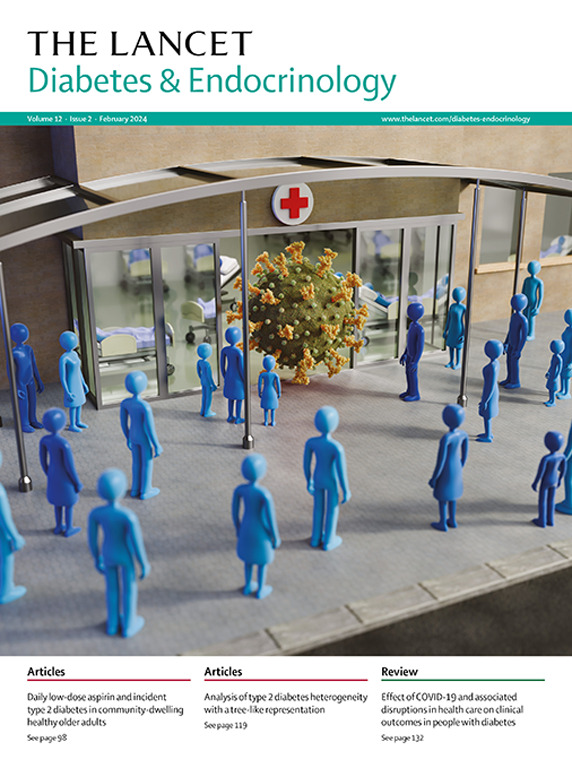Parental preconception BMI and risk of adverse birth outcomes in 8 million parent–child triads: a nationwide population-based cohort study in China
IF 44
1区 医学
Q1 ENDOCRINOLOGY & METABOLISM
引用次数: 0
Abstract
Background
Maternal obesity has been identified as a risk factor for adverse birth outcomes, but the role of paternal obesity (separately and in combination with maternal obesity) on perinatal outcomes remains to be determined. Therefore, this study aims to investigate the independent and joint associations of paternal and maternal BMI with adverse birth outcomes in the general population in China.Methods
This population-based cohort study used data from the National Free Preconception Checkups Project between 2010 and 2020. Parent–child triads with available data on parental preconception BMI and birth outcomes were included. The outcomes included spontaneous abortion, medically induced abortion, preterm birth, small for gestational age (SGA), large for gestational age (LGA), birth defects, and perinatal death. Restricted cubic spline analyses were performed to assess the dose–response relationship and robust Poisson regression models were applied to quantify the risk ratios (RRs) and 95% CIs.Findings
We included 8 787 096 parent–child triads, with an average age of 26·18 (SD 4·33) years for mothers and 27·83 (4·73) years for fathers. Restricted cubic spline analyses showed robust monotonic associations for both maternal and paternal BMI with risk of LGA (positive association) and SGA (inverse association). Both maternal and paternal BMI showed J-shaped associations with all other adverse birth outcomes examined. Compared with a healthy BMI in both parents, we found that preconception BMI categories of underweight, overweight, or obesity in either or both parents were associated with a higher risk of spontaneous abortion, medically induced abortion, perinatal death, preterm birth, birth defects, and composite adverse birth outcome. For instance, the RR of perinatal death was 1·17 (95% CI 1·03–1·33) when both parents had obesity and 1·12 (1·01–1·23) when both parents had underweight. The RR of LGA was 1·70 (1·65–1·74) when both parents had obesity and 0·67 (0·66–0·69) when both parents had underweight. The RR of SGA was 0·73 (0·69–0·76) when both parents had obesity and 1·57 (1·53–1·60) when both parents had underweight. However, regarding all these outcomes as a composite, the risk increased by 10% (RR 1·10 [1·08–1·11]) when the mother had obesity and the father had a healthy BMI, by 4% (1·04 [1·04–1·05]) when the mother had a healthy BMI and the father had obesity, and by 16% (1·16 [1·14–1·18]) when both parents had obesity; the RR when both parents had underweight was 1·08 (1·06–1·09).Interpretation
In this large, nationwide population-based cohort study, a preconception BMI in the category of underweight, overweight, or obesity in either or both parents was associated with a higher risk of various adverse birth outcomes, including perinatal death and birth defects. Therefore, maintaining a healthy weight for both parents before pregnancy is key to perinatal wellbeing.Funding
National Key Research and Development Program of China, National Natural Science Foundation of China, USTC Research Funds of the Double First-Class Initiative, and Anhui Provincial Natural Science Foundation.Translation
For the Chinese translation of the abstract see Supplementary Materials section.父母孕前体重指数与800万亲子三联症不良分娩结局风险:一项基于中国全国人群的队列研究
背景母亲肥胖已被确定为不良出生结局的危险因素,但父亲肥胖(单独或与母亲肥胖联合)对围产期结局的作用仍有待确定。因此,本研究旨在调查中国普通人群中父亲和母亲BMI与不良出生结局的独立和共同关联。方法:这项基于人群的队列研究使用了2010年至2020年国家免费孕前检查项目的数据。包括父母孕前体重指数和出生结果的现有数据的亲子三联。结果包括自然流产、药物流产、早产、小胎龄(SGA)、大胎龄(LGA)、出生缺陷和围产期死亡。采用限制性三次样条分析评估剂量-反应关系,采用稳健泊松回归模型量化风险比(RRs)和95% ci。结果共纳入8 787 096例亲子三联,母亲平均年龄为26.18岁(SD 4.33),父亲平均年龄为27.83岁(SD 4.73)。限制性三次样条分析显示,母亲和父亲的BMI与LGA(正相关)和SGA(负相关)的风险均存在显著的单调关联。母亲和父亲的体重指数与所有其他不良分娩结果均呈j型相关。与父母双方的健康BMI相比,我们发现父母一方或双方的孕前BMI类别体重过轻、超重或肥胖与自然流产、药物流产、围产期死亡、早产、出生缺陷和综合不良出生结局的高风险相关。例如,父母双方均为肥胖时,围产期死亡的RR为1.17 (95% CI为1.03 - 1.33),父母双方均为体重不足时,围产期死亡的RR为1.12 (95% CI为1.01 - 1.23)。父母双方均为肥胖时LGA的RR为1.70(1.65 ~ 1.74),父母双方均为体重过轻时LGA的RR为0.67(0.66 ~ 0.69)。父母双方均为肥胖时,SGA的RR值为0.73(0.69 ~ 0.76);父母双方均为体重过轻时,SGA的RR值为1.57(1.53 ~ 1.60)。然而,将所有这些结果作为综合,当母亲肥胖且父亲BMI健康时,风险增加10% (RR为1.10[1.08 - 1.11]),当母亲BMI健康且父亲肥胖时,风险增加4% (RR为1.04[1.04 - 1·05]),当父母双方都肥胖时,风险增加16% (RR为1.16[1.14 - 1·18]);父母双方体重过轻时的RR为1.08(1.06 - 1.09)。在这项大型的、基于全国人群的队列研究中,父母一方或双方的孕前BMI在体重不足、超重或肥胖类别中与各种不良出生结局(包括围产期死亡和出生缺陷)的高风险相关。因此,在怀孕前保持父母双方的健康体重是围产期健康的关键。国家重点研发计划项目、国家自然科学基金、中国科大“双一流”科研基金、安徽省自然科学基金。摘要的中文译文见补充资料部分。
本文章由计算机程序翻译,如有差异,请以英文原文为准。
求助全文
约1分钟内获得全文
求助全文
来源期刊

The Lancet Diabetes & Endocrinology
ENDOCRINOLOGY & METABOLISM-
CiteScore
61.50
自引率
1.60%
发文量
371
期刊介绍:
The Lancet Diabetes & Endocrinology, an independent journal with a global perspective and strong clinical focus, features original clinical research, expert reviews, news, and opinion pieces in each monthly issue. Covering topics like diabetes, obesity, nutrition, and more, the journal provides insights into clinical advances and practice-changing research worldwide. It welcomes original research advocating change or shedding light on clinical practice, as well as informative reviews on related topics, especially those with global health importance and relevance to low-income and middle-income countries. The journal publishes various content types, including Articles, Reviews, Comments, Correspondence, Health Policy, and Personal Views, along with Series and Commissions aiming to drive positive change in clinical practice and health policy in diabetes and endocrinology.
 求助内容:
求助内容: 应助结果提醒方式:
应助结果提醒方式:


